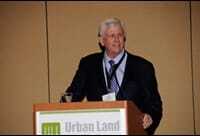| Drew Brown |
Resort communities and hotels have suffered the blows of the recession and are beginning to see the light of day. A panel of developers at ULI’s 2011 Spring Council Forum in Phoenix discussed just how this sector is faring and where the opportunities lie now. Drew Brown, chairman of DMB Associates asked the panel to what degree the resort sector is emerging from the recession. Chuck Cobb, CEO of Cobb Partners said that there is still a huge inventory of real estate and until it’s absorbed, there won’t be a recovery.
Kim Richards, president of the Athens Group, a hotel developer, said, “It’s site specific and region specific. In luxury hotels, no doubt there is a major recovery. It started with a few east coast cities—New York, Washington… the west coast and the Caribbean are lagging.” Francis Najafi, CEO of Pivotal Group countered, “On the ownership side, we’re in early recovery.”
| Jim Chaffin |
Jim Chaffin, chairman of Chaffin Light LLC, offered his insights. He said that there is so much supply that people lack the sense of urgency that was seen previously. And people want to look smart. They want purchases that are smart. That means smaller, more sustainable. They ask, “Will I use it? How much will I use it?” Studies have indicated that second home usage in the U.S. averages about 28 days per year. People are doing the math and see fractional ownership as a more sensible alternative to whole ownership.
Chaffin explained that market segmentation and differentiation are crucial in today’s market. Still, there are 77 million baby boomers. They are at their peak earning years. “Between the ages of 45 and 65 are the sweet spot” when people are most likely to buy second homes. The average buyer is 54 to 55 years old. “The largest number of this age group that has ever lived is alive now.” But people feel less wealthy and a second home no longer is viewed as an entitlement. People value relationships and wellness and seek experiences that enhance those. They seek a shared sense of values. It all comes down to the kind of experience a resort community can provide.
| Chuck Cobb |
Chaffin begins with the question, “Is it beautiful?” There are some constants that will always draw buyers: beauty, water, views, and weather. He is currently developing a resort community on Maryland’s eastern shore, within driving distance of several major metropolitan areas, with a total drive distance population of 14 million. Yes, the site is beautiful, and it includes a manor house that will be converted to a club house. The site is located on a river and will offer a wealth of recreational activities. The residential products being developed will include 60 residence club ownership units and 45 whole-ownership cottages.
Cobb said that the private residence club component of Chaffin’s project is a critical element for the success of the project. The location is also key to its success. Increasingly, resort community developers prefer sites that are close to major metropolitan areas so that they are within a short drive of large numbers of potential buyers and renters.
Renters are another topic of discussion. Owners increasingly offer their units for rent during part of the year so if the development offers a robust rental program that justifies the cost, people are more likely to buy. A reliable exit strategy, or resale program is also important.
| Kim Richards |
The panel agreed that a new trend is urban recreational communities. In the last five years, more money has been spent on cultural experiences than sporting events. This points to an urban context. East-West Partners’ downtown Denver communities are an example of the success that can be achieved with this kind of focus. Other desirable places for such communities include college towns like Charlottesville, Virginia, and historic cities like Charleston, South Carolina.
The national political climate has its implications. Francis Najafi cited questionable public policy and lack of consensus regarding the nation’s $14 trillion federal deficit. If political leaders don’t come together and address this crisis, it will be impossible to plan ahead. Cobb pointed out that the likely result will be inflation and higher interest rates, which aren’t necessarily a bad thing for developers who take advantage of the bargains available today.
When asked what “big ideas” they could offer, Chaffin said, “We have to view the market differently. It’s about the experience, not the real estate. The buyer wants to know what life will be like. It’s important to create a happy place.” Brown added that developers need a way to tell buyers what they’re getting.
| Francis Najafi |
Najafi said that while today’s buyers haven’t changed demographically, their wealth has changed. They’re more concerned with getting value. From the developer’s perspective, it is beneficial to develop in a proven destination with major amenities already in place. It can be too costly to begin from scratch.
Richards believes that part of the creative aspect of being a developer is being the exception to the rule.
Cobb said this is the time to prepare for the rebound. Developers should identify opportunities to purchase property at today’s discounted prices. Chaffin said that the best years he and his partner ever had were the 3 years following each recession.








